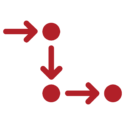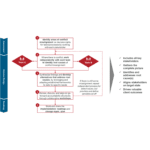
What are role accountabilities and decision rights?
Role accountabilities are developed by defining responsibilities for individuals or teams. Identifying accountabilities helps team members to understand their purpose, deliverables, and performance expectations. The result is effective coordination, collaboration, and a strong sense of ownership throughout an organization.
Decision rights are crucial for organizational effectiveness. They determine who has the authority to make decisions and specifically define the role of other stakeholders in the decision-making process. Allocating decision rights empowers individuals and teams, avoiding delays, oversight, and confusion over responsibilities.

How we can help you establish clear roles, accountabilities, and decision rights
We draw on our organizational design experience to help you develop a target state for your structure, team mandates, and roles. We leverage responsibility frameworks, such as RACI (responsible, accountable, consulted, informed), to help you clearly define decision rights across your organization. We can customize any framework to fit your organization.
In addition to helping you establish clear decision rights, we can help you to resolve misalignments and decision conflicts.
Benefits of working with us to establish accountabilities and decision rights:
- • A better understanding of responsibilities, deliverables, and performance expectations for individuals and teams
- • A strong sense of ownership among team members
- • A quicker and more efficient decision-making processes
- • Fewer delays and less oversight and confusion over responsibilities
- • Improved organizational effectiveness
Our approach to resolving decision conflicts
Without clearly defined roles, accountabilities, and decision rights, misalignment can occur throughout an organization. Misalignments can lead to decision conflicts, ineffective decision-making, and duplicated tasks.
We take a unique approach to increasing organizational effectiveness drawing on our experience working with clients to resolve misalignment issues. Our five-step approach identifies issues and flexibly applies and adapts frameworks to make them fit for purpose.

1. Identify areas of conflict and misalignment: We meet with all key stakeholders and review process documents to gain insight and prioritize areas of conflict, focusing on the most pressing issues to increase the impact of our approach.

2. Identify the root causes of conflict: Key stakeholders share their perspectives through a confidential platform so we can gather a detailed analysis of issues. We work confidentially to gather a less constrained analysis, enabling us to identify root causes and core drivers of misalignment.

3. Synthesize findings, design alternatives, and leverage a framework: We develop potential solutions and design alternatives to address roles and decision rights. Our approach builds off areas of alignment, addresses the root issues, leverages and adapts existing frameworks, and provides a strong foundation for conflict resolution.

4. Determine the go-forward accountability structure: We review and discuss the alternatives in a collaborative workshop to align on the go-forward accountability structure. We identify areas of misalignment, highlight areas of alignment, and propose the most suitable alternative accountability structures to resolve misalignment issues.

5. Create an implementation roadmap and change management plan: Leaders and employees must commit to the change, communicate updates, and follow a governance structure to ensure the organization achieves buy-in from all key stakeholders.
How Burnie Group creates value
Through Burnie Group’s experience working with clients across industries, we can help:
- Adapt decision-making frameworks to meet client-specific needs, driving more impactful results
- Develop a structured, iterative approach to identify root causes and address all areas of conflict
- Improve organizational effectiveness through enhanced role clarity and defined decision-making authority
Our insights on accountability and decision rights
Find out how we can help you resolve conflicts and establish role accountabilities and decision rights.
CONTACT US






